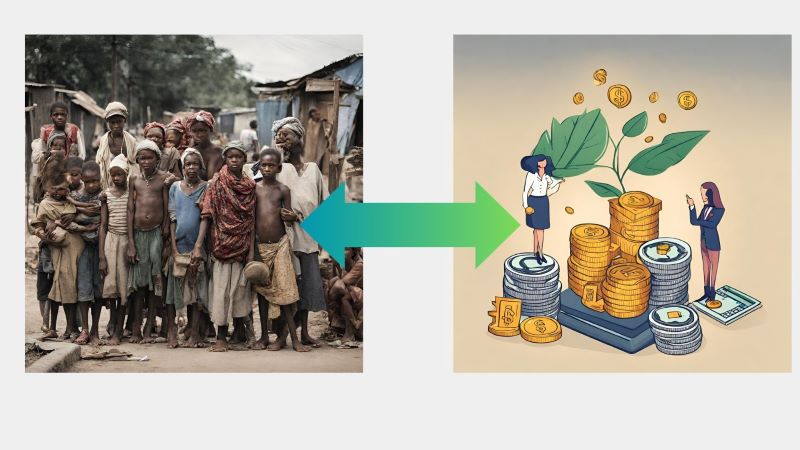In a nation as diverse and dynamic as India, the pursuit of financial prosperity is a common aspiration shared across all socio-economic strata. While the journey to wealth may seem daunting for those belonging to the lower economic class, it’s important to recognize that with determination, education, and strategic planning, achieving financial success is indeed within reach. In this article, we’ll explore actionable strategies tailored to empower lower-class Indians in their quest to build wealth and secure a brighter future for themselves and their families.

1. Embrace Financial Education
One of the fundamental pillars of wealth creation is financial literacy. Lower-class individuals should prioritize educating themselves about basic financial concepts such as budgeting, saving, investing, and debt management. Fortunately, numerous resources are available, including online courses, workshops, and financial literacy programs offered by government agencies and non-profit organizations. By arming themselves with knowledge, individuals can make informed decisions regarding their finances, laying the groundwork for long-term prosperity.
2. Cultivate a Savings Mindset
Saving money, no matter how modest the amount, is the first step towards wealth accumulation. Lower-class individuals can cultivate a savings mindset by adopting frugal habits, such as cutting unnecessary expenses, avoiding impulse purchases, and setting aside a portion of their income for savings regularly. Automated savings tools, such as recurring deposits or systematic investment plans (SIPs), can help facilitate this process by ensuring consistency and discipline in saving habits.
3. Invest Wisely
While saving is crucial, investing offers the potential for exponential growth of wealth over time. Lower-class individuals can explore various investment options suited to their risk tolerance, financial goals, and investment horizon. These may include:
- SIPs in Mutual Funds: Systematic investment plans (SIPs) allow individuals to invest small amounts regularly in mutual funds, enabling them to benefit from the power of compounding and diversification.
- Public Provident Fund (PPF): PPF is a government-backed savings scheme that offers attractive interest rates and tax benefits. Lower-class individuals can consider opening a PPF account to build a long-term savings corpus.
- Stock Market Investments: While investing in stocks carries higher risks, it also offers the potential for significant returns. Lower-class individuals can start small by investing in blue-chip stocks or opting for index funds that track market performance.
- Real Estate: Investing in real estate, either through direct property ownership or real estate investment trusts (REITs), can be another avenue for wealth creation, albeit requiring substantial capital and thorough research.
4. Pursue Skill Development and Entrepreneurship
Empowerment through skill development and entrepreneurship can provide lower-class individuals with the means to generate additional income streams and break free from the cycle of poverty. Government initiatives, vocational training programs, and skill development courses can equip individuals with valuable skills that are in demand in the job market. Furthermore, aspiring entrepreneurs can explore small business opportunities in sectors such as agriculture, handicrafts, retail, and services, leveraging their skills and creativity to create sustainable livelihoods.
5. Leverage Technology and Financial Inclusion
The advent of technology has revolutionized financial services, making them more accessible and inclusive than ever before. Lower-class individuals can leverage digital banking, mobile payment platforms, and microfinance institutions to access financial products and services tailored to their needs. Mobile banking apps, digital wallets, and peer-to-peer lending platforms can facilitate transactions, savings, and credit access, empowering individuals to manage their finances more efficiently and securely.
6. Foster a Culture of Saving and Investment in Families and Communities
Building wealth is not only an individual endeavor but also a collective effort that involves families and communities. Lower-class individuals can foster a culture of saving and investment within their families and communities by sharing knowledge, experiences, and success stories. Collective saving schemes, informal investment clubs, and community-based initiatives can provide a support system and collective resources to help individuals achieve their financial goals collaboratively.
Conclusion
Achieving financial success as a lower-class individual in India requires a combination of perseverance, resourcefulness, and strategic planning. By prioritizing financial education, cultivating a savings mindset, investing wisely, pursuing skill development and entrepreneurship, leveraging technology and financial inclusion, and fostering a culture of saving and investment, lower-class Indians can overcome socio-economic barriers and unlock pathways to prosperity. While the journey may be challenging, the rewards of financial independence, security, and generational wealth are well worth the effort. With determination and resilience, every individual has the potential to realize their dreams of a better and brighter future.




